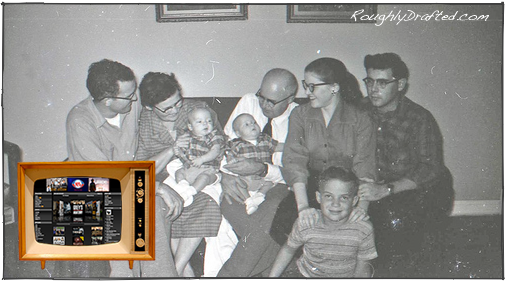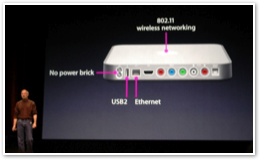
Five Ways Apple Will Change TV: 2
Why Apple Will Change TV presented similarities between the iPod and iTV, and introduced how Apple is poised to add value to existing content using the iTV in much the same way that the iPod added value to CD and MP3 music collections. Here's the second of Five Ways Apple Will Change Your TV.
The previous article considered how Apple is pioneering delivery of on-demand commercial content, in particular music, movies and television programming. Apple also has investments in the production of that content, with pro software tools such as Final Cut Pro and Logic, as well as hardware engineered for audio and video production work, from the Mac Pro to the Xserve RAID.



#2: Personal Content
Apple also builds production tools for a wider audience: the rest of us. Apple's digital hub may have started with iTunes, but now it's a suite that includes iMovie, GarageBand and iPhoto. Each is designed to catalog and polish personal content.
While people are passionate about Hollywood movies and pop songs, their own photos, home movies, and other creations are considered priceless.
However, while many manufacturers are good at producing impressive cameras and camcorders that push the technical envelope in hardware, very few deliver even passable consumer software for managing, editing, and presenting the content those devices create.
The Sorry State of Software
Despite controlling the desktops of the vast majority of computer users, Microsoft has only half-heartedly rolled out a few weak and entirely derivative apps for editing movies or cataloging photos.

Because Microsoft sees no immediate profits in producing bundled software, it only needs to produce titles that fill a checklist of Windows' marketing points. The lack of enthusiasm is evident in the finished products.
Individual PC makers such as Sony have attempted to differentiate their Windows PC offerings by throwing in a few truly awful creative titles. Every year, Sony dumps out another bundle of VAIO software that is ugly, inconsistent, and barely usable. It's not updated, it just gets replaced with another set of titles bundled in the next year's batch of Sony PCs.
HP makes more efforts to build its own applications for managing photos, and in particular printing and scanning, two areas of HP's hardware expertise. But install some HP software and your impression of the company will drop precipitously. HP's end user software is so bad on so many levels that the only explanation is that, for whatever reason, HP is trying to make Cisco software look better in comparison. 

It's a Wonderful iLife
The abject failure across the tech world to build usable creative software for consumers contrasts sharply with Apple's iLife offerings. Not only are iLife applications fairly intuitive and easy to use productively, but Apple also devotes a lot of ongoing development resources into incrementally improving them.
 It's worth noting that Apple didn't deliver its iLife suite by hiring a committee of marketing visionaries to find synergies between buzzwords. Success doesn't come from fooling customers with ads, it comes from hard work: delivering a good product and constantly refining it.
It's worth noting that Apple didn't deliver its iLife suite by hiring a committee of marketing visionaries to find synergies between buzzwords. Success doesn't come from fooling customers with ads, it comes from hard work: delivering a good product and constantly refining it. The iLife suite gets overhauled every year, and it's updated regularly throughout the year. Apple also provides support forums and online training, as well as regular training sessions in the company's retail store theaters. That's a lot of resources to devote toward personal content. Apple's doing it because it recognizes the value of utility: useful software sells hardware.

Good Cheap Software, Bad Cheap Hardware
Apple gives iLife away to new Mac buyers, and annual updates are now $79. Even excluding the free iTunes, that's around $15 per application: shareware prices! Clearly, Apple doesn't approach iLife as a huge money maker. Rather, its an effort to differentiate the Mac and provide value to users.
Contrast this with HP: since the reign of Carly the Terrible, HP's focus has revolved around driving consumer hardware prices lower to expand market share. This has eroded HP's (and Compaq's) former reputation for high quality hardware.
HP has no problem so far in selling its tragically cheap hardware bundled with inconsistent and sloppy software, but consumers can't be fooled forever.
I’ve bought generations of HP printers in the past that worked like tanks, but after buying a few of the new flimsy printers, some crappy laptops, and a worthless scanner, I can’t imagine ever buying new HP gear in the future.
Where does iTV fit into this? As you've probably guessed, it plays back all that iLife personal content on users' TVs. It's a simple solution that doesn't require professional installation.
It simply plugs into the TV, and through the magic of Bonjour and wireless networking, it finds shared photos and home movies on computers around the house, and presents them for display.
I noted earlier how downloadable commercial content from the iTunes Store won't be saturating the bandwidth of the iTV's HDMI connector anytime soon.
HD or even DVD video is simply too fat to fit through the tiny tubes of the Internet. However, with wireless n or even Fast Ethernet, it's no problem to locally beam HD photos and video camera home movies to the TV after editing and cataloging them in iLife apps.
Apple has been developing and refining its iLife applications for years, for an installed base of millions of users worldwide.
The rest of the industry is trying to develop web applications to manage photos and home movies, but Apple's suite of tightly integrated apps offer a lot more utility for basic users who just want things to work and be easy to use and understand. The iTV will simply allow Apple to add value by providing a new way to show off personal content.
Conspiracy Theories
People like to worry that Apple is on a plot to world domination and is trying to stifle any competition to the commercial content offered in the iTS. However, that's not what brought Apple success with the iPod. The company's success in the last decade isn't attributable to a series of fortunate coincidences, so it's clear Apple has a strategy.
Apple added value to users’ existing music collection with the iPod, without demanding they also buy rental subscriptions, or other online purchases of any kind. With the iTV, Apple is similarly adding value by providing:
-
•easy to use ways of viewing and sharing personal content
Notice that Apple makes no direct money from putting baby photos and family vacation videos on TV. Instead, the company is providing value that will result in other sales. The iTS downloadable content similarly does not make Apple huge sums of cash; it does add value for consumers, giving them a choice they didn’t have before. Both are complementary; Apple doesn't have to make a profit at every turn, it merely has to add value.
Rather than offering products that add value, many of Apple's competitors have been blinded by their own greed and are working so hard to monetize every step that they've failed to grasp the basic tenant of business: if you don't provide value for customers, they will go elsewhere.
But that's only the first two ways Apple is adding value with the iTV. Three more to come, so stay tuned for the third reason Apple will change TV in ways nobody else has been able.
This Series










Monday, October 2, 2006




 Bookmark on Del.icio.us
Bookmark on Del.icio.us Discuss on Reddit
Discuss on Reddit Critically review on NewsTrust
Critically review on NewsTrust Forward to Friends
Forward to Friends
 Get RSS Feed
Get RSS Feed Download RSS Widget
Download RSS Widget





